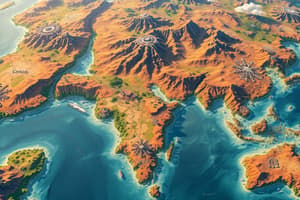Podcast
Questions and Answers
What is the primary purpose of a map projection?
What is the primary purpose of a map projection?
- To show country borders and political boundaries
- To accurately depict the Earth's curved surface on a 2D plane (correct)
- To display natural features such as mountains and rivers
- To preserve angles and shapes well
Which type of map projection preserves angles and shapes well, but distorts size and scale near the poles?
Which type of map projection preserves angles and shapes well, but distorts size and scale near the poles?
- Mercator projection (correct)
- Gall-Peters projection
- Topographic projection
- Azimuthal projection
What is the primary difference between a verbal scale and a representative fraction?
What is the primary difference between a verbal scale and a representative fraction?
- The level of accuracy provided
- The way the scale is expressed (correct)
- The type of map it's used for
- The unit of measurement used
What type of map is best suited to show relief and elevation?
What type of map is best suited to show relief and elevation?
What is the purpose of a legend on a map?
What is the purpose of a legend on a map?
What is an inset on a map?
What is an inset on a map?
What is the primary purpose of a title on a map?
What is the primary purpose of a title on a map?
What is the primary difference between a physical map and a topographic map?
What is the primary difference between a physical map and a topographic map?
What is the purpose of a grid on a map?
What is the purpose of a grid on a map?
Flashcards are hidden until you start studying
Study Notes
Map Projections
- A map projection is a way to represent the curved surface of the Earth on a 2D plane
- There are many types of map projections, each with its own strengths and weaknesses
- Some common map projections include:
- Mercator projection: preserves angles and shapes well, but distorts size and scale near the poles
- Gall-Peters projection: attempts to preserve size and shape, but distorts angles
- Azimuthal projection: preserves shapes and angles well, but distorts size and scale
Map Scales
- Map scale refers to the ratio of the distance on the map to the corresponding distance in reality
- Map scales can be expressed as:
- Verbal scale (e.g. "1 inch = 1 mile")
- Representative fraction (e.g. 1:50,000)
- Linear scale (e.g. 1 cm = 1 km)
Map Types
- Political maps: show country borders, capitals, and other political boundaries
- Physical maps: show natural features such as mountains, rivers, and lakes
- Topographic maps: show relief and elevation, often using contour lines
- Thematic maps: show specific data or patterns, such as climate, population, or economic activity
Map Elements
- Title: indicates the map's topic or region
- Legend: explains the symbols and colors used on the map
- Scale: indicates the ratio of distance on the map to reality
- Orientation: indicates the direction of north
- Grid: a network of lines that help locate points on the map
- Inset: a smaller map that shows a larger area or provides additional context
Map Projections
- Map projections represent the Earth's curved surface on a 2D plane
- Various map projections exist, each with strengths and weaknesses
- Mercator projection preserves angles and shapes but distorts size and scale near poles
- Gall-Peters projection preserves size and shape but distorts angles
- Azimuthal projection preserves shapes and angles but distorts size and scale
Map Scales
- Map scale is the ratio of distance on the map to the corresponding distance in reality
- Map scales can be expressed as verbal scales, representative fractions, or linear scales
- Verbal scale examples include "1 inch = 1 mile"
- Representative fraction examples include 1:50,000
- Linear scale examples include 1 cm = 1 km
Map Types
- Political maps show country borders, capitals, and other political boundaries
- Physical maps display natural features like mountains, rivers, and lakes
- Topographic maps show relief and elevation using contour lines
- Thematic maps display specific data or patterns, such as climate, population, or economic activity
Map Elements
- Title indicates the map's topic or region
- Legend explains symbols and colors used on the map
- Scale indicates the ratio of distance on the map to reality
- Orientation indicates the direction of north
- Grid is a network of lines that helps locate points on the map
- Inset is a smaller map that shows a larger area or provides additional context
Studying That Suits You
Use AI to generate personalized quizzes and flashcards to suit your learning preferences.




